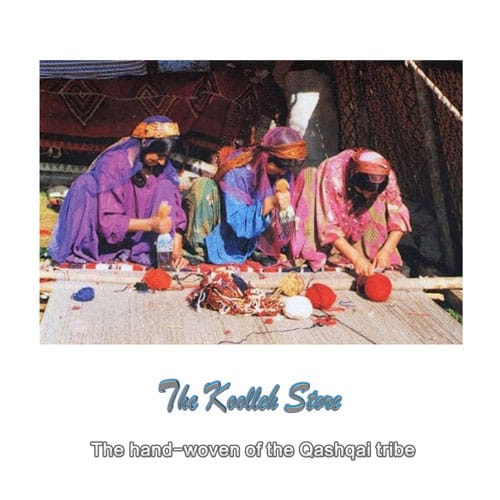The hand-woven of the Qashqai tribe

In general, Qashqai weaves can be divided into two general categories: fluffy (carpet, gabbeh) and non-fluffy (kilim, needle, plus, etc.) and practical weaves (jelly, sesame, salt shaker, etc.). .
After Islam, according to historical documents, carpet weaving was so common in the Persian region that it could not have been achieved without the support of centuries of experience. This ancient art and this weighty cultural value will be more than 2,500 years old.
Because the birthplace of Persian civilization and the pride of Iran was Cyrus the Great. According to studies by Cyrus Parham, he divided the Persian carpet weaving regions into three categories: the first region of the Baron Takhtar region, which included larger and richer cities, and he named Darabgard or Darab-e-Amrooz, Fasa and Jahrom.
The second area of Bishabour kiln, which extends to the outskirts of Arjan and the Lorestan land of Kohkiluyeh, and Shapur, Kazerun, Toj (Tuz) and the lost city of Nahanjan are its main cities, both of which were the most prosperous centers of Sassanid civilization. The third is Bavanat and Qonqari (from the pool furnace) whose fort was the fortress of Khamra.
The first historical document about the carpet weaving of this region was obtained from the tribute and tax of this land in the second century AH to the Caliph of the time and in his book Al-Buwayh and his time he mentions several thousand boards of Dabjerd carpet (Darab) in Anbar treasury.
In the book Hudood al-Alam Man al-Sharq al-Gharb, it is stated that from Persia, carpets and rugs, carpets and rugs are expensive.
This statement clarifies all the weaves with lint and without lint in the name, and the author’s use of rugs and carpets along with kilims and zillows indicates this.
“In Jahrom, there were excellent engraved clothes, but the long kilim and jajim and the prayer rug and the clarity of Jahrom, which is known in the world as Jahromi, are unparalleled, and in the same book it is stated that: Tabari was performed and Moqaddisi Bashari, an Arab traveler, said that good carpets are woven in the land of Persia, and that various types of carpets are sent to other lands from this region.
Pope says in his book Ackerman A Survey of Persian: During the Khanate dynasty, when Tabriz was one of the centers of carpet weaving, Ghazan Khan ordered his palaces to Persian weavers.
Cyrus Parham considers Persia to be the owner of ancient carpet weaving for another reason and considers the existence of weaving tribes such as Arabs, who are Hejazi immigrants living in Persia, to be without ancient carpet weaving and considers the learning of this technique from Persian tribes in this land.
But in the ninth and tenth centuries AH, with the footsteps of the pioneers of the Qashqai Turkic-speaking people in Persia, the art and industry of carpet weaving in this region flourished and this industry became more and more concentrated in the tribal areas.
But these new nomadic tribes, who did not have permanent housing, were so unfamiliar to historians and tourists that their handicrafts were registered in the name of others. And perhaps this is the reason why Illyrian carpet weaving is not mentioned in ancient texts.
But this and the subject cannot divert us from looking for Persian carpet weaving in urban areas. Tribal tribes and clans among Qashqais:
Parham named the Kashkuli clan, the six-block clan, the Amla clan, the Safi Khani clan, the Igdar clan, the Changi clan and the Shuri Valley clan as Persian tribes and weavers.






